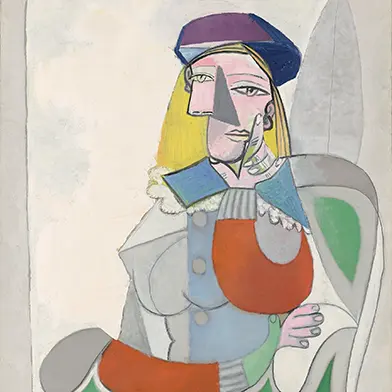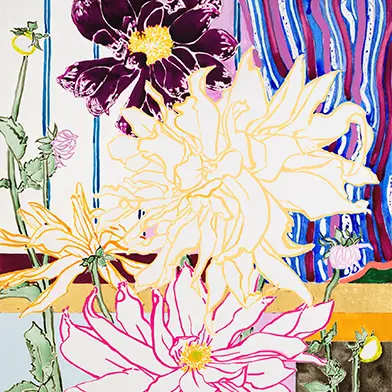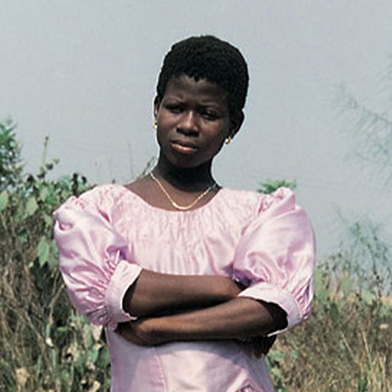The gallery started to represent Bruno Knutman in 2012 and showed his last two solo exhibitions; Serious Times (2015) and Night Piece (2018). After his passing, we have collaborated with the artist’s family. In 2021, his ink drawings, made between 1964 and 1990, were presented in the exhibition In the Basement Studio.
Anders Kreuger, curator, writer and lecturer, has written a text for the exhibition catalogue, which can be read in its entirety below. Since 2019, Kreuger has been the director of the private kunsthalle Kohta in Helsinki, Finland, and in 2010 he made the exhibition Wolf at the Door with Bruno Knutman at Lunds konsthall, Sweden. On Tuesday April 29, we will host a conversation between Kreuger and artist Jens Fänge about the exhibition.
Bruno Knutman – The Remote Viewer
The gouache is a covering water-soluble paint with pigments held together by gum arabic, yielding a dry, greyish surface. It represents a continuation of late medieval glue-size painting. Both these media help the artist commit a pictorial idea to a surface before it slips away, like the dreams of late morning once we make up our mind to commit to wakefulness. The gouache is not primarily about making a sketch or a study – that has traditionally been the case with its cousin, the watercolour – but rather about achieving a look that is finished enough to secure the continued existence of the image. The artist may then choose to let it shine in a more fluid and more demanding medium or to leave it at that.
It is therefore not entirely clear if gouache painting is an art form in its own right or if it should be regarded as one of the techniques certain significant painters have used. Adolph Menzel is among the finest, alongside François Boucher, Joseph William Mallord Turner and Henri de Toulouse-Lautrec. In Swedish art history names such as Egron Lundgren, Anders Zorn or Lennart Rodhe come to mind. The singular Bruno Knutman (1930–2017) should be added to those, not least because he really deserves some international recognition. It is worth thinking about why he has become a prime Swedish example of an ‘artists’ artist’, more appreciated by fellow artists than by wider audiences.
Knutman is also a telling example of why we should be cautious with that other slippery value judgment, the ‘minor classic’, which tries to re-evaluate the devaluated but achieves the opposite. A brief explication might be called for.
What is the real reason why Knutman’s practice has been judged ‘off-centre’? This tends to mean ‘less significant’, but also ‘worthy of more attention than it has received’ and consequently ‘ripe for rediscovery’. It is of course to do with what works in the market, but not only. Perhaps more importantly, It is to do with what the wider art context, which includes the public institutional sphere, decides to call ‘consistent’ or ‘uncompromising’ on the one hand and ‘insistent’ or ‘intransigent’ on the other. Since the mid-1960s it is, above all, to do with that non-descript epithet, ‘engaged’.
During his lifetime Knutman’s dream-like, strongly personal and formally ambiguous visual universe never quite made the journey from the singular to the engaged, from what is merely worthy of interest to what is truly interesting: that which yields commercial interest. There must have been several reasons. Knutman must have been rather uninterested in appearing to be complex or sophisticated. He must have refrained from choosing between speaking of himself and others in images and letting images have their own lives and meanings. He must have avoided situations where he needed to show trust in middlemen such as dealers or curators. He must have felt more in tune with himself as a ten-year-old than with his contemporaries’ expectations of a seventy- or eighty-year-old image-maker.
I myself had the chance to collaborate with him on his partly retrospective solo exhibition at Lunds konsthall, ‘Wolf at the Door’, in 2010. I got to know him a little bit, and that is precisely why I choose not to make overdetermined statements about his intentions. In my experience, every ‘real’ artist is to some extent opaque.
I believe that the gouaches Magnus Karlsson has now chosen to exhibit provide evidence for what I have said here. They convey visions born from the encounter between Knutman’s inner world and the landscape around him (The Wheat Field, 2005; Kåseberga Hills, 2006). They merge illusory backdrops with ‘actors’ reduced to emblematic silhouettes (Sunday Afternoon, 1991); Knäbäck in Memoriam, 1991; Secret Encounter, 1997; The Proposal, 1999). They stage, with similar methods, his own memory images from art school in London and the studio in Lund (The Gouache Painter, 1979; The Study, 1985; Fateful Drama, 1991). Sometimes they veer towards the macabre and the occult (Food for the Spirit, 1991; Games of the Night, 1991; Mystery Play, 1991). Other times they reconnect to what appears to have been a fictitious childhood idyll (Beach Outing, 2002; Happy Days, 2005).
Bruno Knutman’s gouaches from the 30 years between 1979 and 2009 move between what is clearly spelled out and what is purposely kept behind a thin film of opaque white. The technique makes even the darker parts of his motifs look like stations on a pilgrimage from shadow to light, from the already seen to the yet unseen, the sun’s descent and ascension. It is suitable that the exhibition lends its title from The Remote Viewer (1996) and its Janus head (or its two profiles in interaction).
- Anders Kreuger
Bruno Knutman, ’Gouachemålaren / The Gouache Painter’, 1979. Gouache on paper, 64x49 cm


